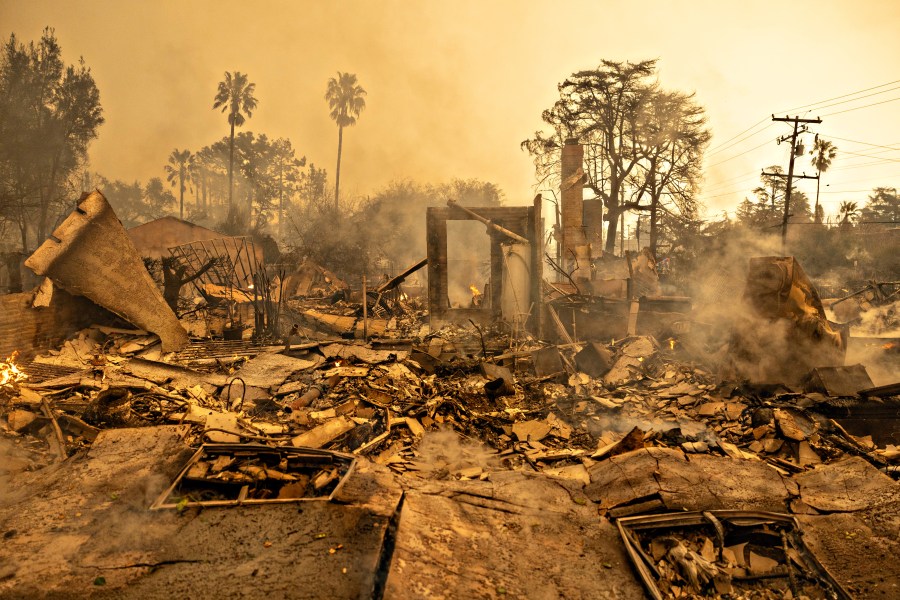
In the aftermath of Southern California’s wildfires, health experts are warning residents about the dangers of toxins still lingering in the air.
According to the U.S. Environmental Protection Agency, ash, smoke, and other chemicals can easily penetrate homes and buildings.
“During wildfires and other combustion-related activities, the concentration of particles in the air can increase significantly to the point where particle pollution is visible to the naked eye,” the EPA says.
“This level of smoke, air pollution, ash and chemicals can irritate our lungs and upper airways,” said Dr. Afif El Hasan, an asthma specialist at Kaiser Permanente in Orange County. explain.
Elhassan said there has been an increase in patients with respiratory illnesses since the Palisades and Eaton fires broke out on Jan. 7.
Air quality continues to deteriorate across the Southland region as the Hughes Fire broke out near Castaic on Wednesday.
“The best treatment is to stay indoors as much as possible and make sure you have a proper air filtration system in your home,” Elhassan advised. “If you must go out, we recommend wearing a mask. N95 masks are probably the most affordable mask available.”
Toxic chemicals can linger in the air for days or even weeks after a wildfire is extinguished. As some residents return to their homes, many are concerned about the negative effects on their health.
Pasadena resident Tracy Samczyk said her backyard is filled with ash, soot and other harmful particles from the Eaton Fire. She cleans up residue from her garden, worrying about exposure to toxins.
‘Do I throw this away or do I clean it?’ I don’t know what to do,” Samczyk said of his belongings. “I’m worried about the long-term effects, not just on us but on our neighbors. We’re lucky we had ventilators, goggles and gloves, but we can only do a little bit at a time. Even with protective gear on, it’s not over. I still felt sick afterwards.”
Lt. Matt Phillips, left, of the Kitsap County Fire Strike Team on Bainbridge Island, Washington, inspects a home for structural problems in the aftermath of the Palisades Fire in the Pacific Palisades neighborhood of Los Angeles on Friday. is conducting. January 17, 2025. (AP Photo/Richard Vogel) A resident and his dog watch from a dog park as smoke from the Palisades Fire rises over a ridge in the Encino neighborhood of Los Angeles on Saturday, Jan. 11, 2025. (AP Photo/Richard Vogel) ALTADENA, CA – JANUARY 8: Remains of a home lost in the Eaton Fire on Wednesday, January 8, 2025 in Altadena, California. (Jason Almond/Los Angeles Times via Getty Images) Firefighters watch as water is sprayed on the Palisades Fire in Mandeville Canyon in Los Angeles, Saturday, January 11, 2025. (AP Photo/Jae C. Hon) A helicopter drops water on the Hughes Fire as firefighters monitor the blaze Wednesday, Jan. 22, 2025, in Castaic, California. (AP Photo/Marcio Jose Sanchez) Firefighters are working to contain the spread of the fire. Wednesday, January 22, 2025 at the Hughes Fire in Castaic, California. (AP Photo/Ethan Swope) Property damaged by fire The Palisades Fire seen from the shoreline in the Pacific Palisades neighborhood of Los Angeles, Friday, Jan. 17, 2025. (AP Photo/Carolyn Custer) A home destroyed in the Palisades fire is seen Thursday in the Pacific Palisades neighborhood of Los Angeles. , January 16, 2025. (AP Photo/Damian Dovarganes) Firefighters monitor the blaze caused by the Hughes Fire along roads in the city. Castaic, California, Wednesday, January 22, 2025 (AP Photo/Ethan Swope)
Health experts say it’s best to hire professional cleaners to clean homes covered in ash and soot if possible. Although firefighters have almost completely extinguished the Palisades and Eaton fires, experts warn that health risks from poor air quality remain.
“People need to remain vigilant as particles and chemicals continue to be released into the air,” Elhassan said. “Chemicals such as pollution, soot and smoke can be present for weeks and even months.”
People living in areas affected by smoke should:
Limit exposure by staying indoors with windows and doors closed, or by seeking alternative shelter. Avoid strenuous physical activity. Operate the air conditioner or air purifier. If possible, avoid using swamp coolers or whole-house fans that draw in outside air. Avoid burning wood in fireplaces and fireplaces, and minimize sources of indoor air pollution such as candles, incense, frying pans, and grills. If you must be outdoors, a properly fitted N95 or P100 mask may provide some protection.
Source link




